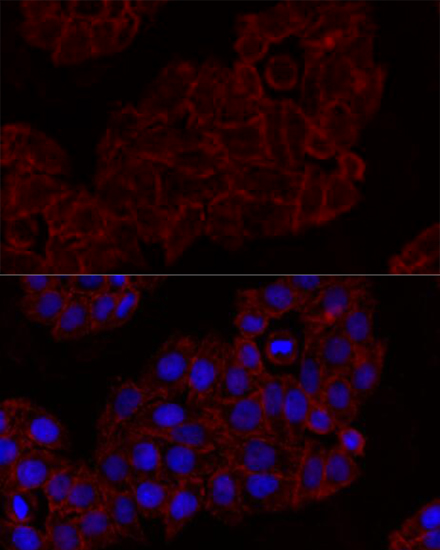| Background: | Natural killer (NK) cells are lymphocytes that can mediate lysis of certain tumor cells and virus-infected cells without previous activation. They can also regulate specific humoral and cell-mediated immunity. NK cells preferentially express several calcium-dependent (C-type) lectins, which have been implicated in the regulation of NK cell function. The NKG2 gene family is located within the NK complex, a region that contains several C-type lectin genes preferentially expressed in NK cells. This gene encodes a member of the NKG2 family. The encoded transmembrane protein is characterized by a type II membrane orientation (has an extracellular C terminus) and the presence of a C-type lectin domain. It binds to a diverse family of ligands that include MHC class I chain-related A and B proteins and UL-16 binding proteins, where ligand-receptor interactions can result in the activation of NK and T cells. The surface expression of these ligands is important for the recognition of stressed cells by the immune system, and thus this protein and its ligands are therapeutic targets for the treatment of immune diseases and cancers. Read-through transcription exists between this gene and the upstream KLRC4 (killer cell lectin-like receptor subfamily C, member 4) family member in the same cluster. |
| UniProt Protein Function: | Function as an activating and costimulatory receptor involved in immunosurveillance upon binding to various cellular stress-inducible ligands displayed at the surface of autologous tumor cells and virus-infected cells. Provides both stimulatory and costimulatory innate immune responses on activated killer (NK) cells, leading to cytotoxic activity. Acts as a costimulatory receptor for T-cell receptor (TCR) in CD8+ T-cell-mediated adaptive immune responses by amplifying T-cell activation. Stimulates perforin-mediated elimination of ligand-expressing tumor cells. Signaling involves calcium influx, culminating in the expression of TNF-alpha. Participates in NK cell-mediated bone marrow graft rejection. May play a regulatory role in differentiation and survival of NK cells. Binds to ligands belonging to various subfamilies of MHC class I-related glycoproteins including MICA, MICB, RAET1E, RAET1G, RAET1L/ULBP6, ULBP1, ULBP2, ULBP3 (ULBP2>ULBP1>ULBP3) and ULBP4. |
| NCBI Summary: | This locus represents naturally occurring read-through transcription between the neighboring KLRC4 (killer cell lectin-like receptor subfamily C, member 4) and KLRK1 (killer cell lectin-like receptor subfamily K, member 1) genes on chromosome 12. The read-through transcript includes an alternate 5' exon and lacks a significant portion of the KLRC4 coding sequence, including the start codon, and it thus encodes the KLRK1 protein. [provided by RefSeq, Dec 2010] |
| UniProt Code: | P26718 |
| NCBI GenInfo Identifier: | 128370 |
| NCBI Gene ID: | 100528032 |
| NCBI Accession: | P26718.1 |
| UniProt Secondary Accession: | P26718,Q9NR41, A8K7K5, A8K7P4, |
| UniProt Related Accession: | P26718 |
| Molecular Weight: | 25,274 Da |
| NCBI Full Name: | NKG2-D type II integral membrane protein |
| NCBI Synonym Full Names: | KLRC4-KLRK1 readthrough |
| NCBI Official Symbol: | KLRC4-KLRK1 |
| NCBI Protein Information: | NKG2-D type II integral membrane protein |
| UniProt Protein Name: | NKG2-D type II integral membrane protein |
| UniProt Synonym Protein Names: | Killer cell lectin-like receptor subfamily K member 1; NK cell receptor D; NKG2-D-activating NK receptor; CD_antigen: CD314 |
| Protein Family: | NKG2-D type II integral membrane protein |
| UniProt Gene Name: | KLRK1 |







